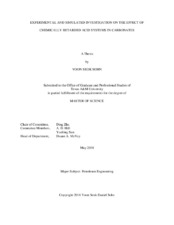| dc.description.abstract | In carbonate acidizing, wormhole development is crucial to the stimulation result. The acid reactivity and injection rate both play important roles in this process. Because the reactivity of HCl with carbonate is high, it is essential to control the diffusion rate and reaction rate in order to generate the most effective wormholes. In a typical interstitial velocity (vᵢ) to pore volume to breakthrough (PVʙт) graph, there exists an optimal point for each curve at which a given amount of acid creates a wormhole that penetrates deepest into the wellbore. In order to improve the efficiency of acidizing and maximize the impact of the stimulation, acid transport and reaction rates need to be balanced. Both physical and chemical means could achieve this goal. Chemical reduction of reactivity employs various chemicals to inhibit the rapid reaction from taking place.
In this study, the wormholing phenomena of three types of novel acid systems were investigated via matrix acidizing coreflood experiments to assess their performance. The results were compared with the performance of conventional 15% HCl. With the experimental data, wormhole length could be calculated with a given volume of acid at their optimal point, as well as reduction in skin and ultimately the impact on production rate. An extensive mathematical modeling of wormhole development was conducted to evaluate their applicability in field scale.
The results show that the optimum PVʙт and vᵢ values of the chemically retarded acids were lower than those of 15% HCl. These novel acids generate wormholes more efficiently at lower vi compared to 15% HCl. The mathematical modeling also shows that the novel acids performance is better in terms of productivity increase, wormhole penetration length, and skin reduction. | en |


